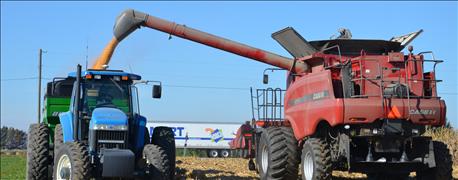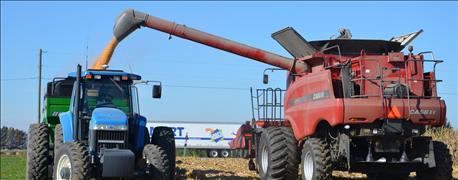
Nearly everyone was challenged by wet conditions when they wanted to plant in the spring of 2016. A few people also dealt with wet soils at harvest. If you encountered soils that were wetter than you'd like at one or both times last season, you may have faced the dilemma of how to minimize soil compaction but still get the crop planted or harvested in a timely manner.

SMART CHOICES: Specialists advise staying off soils when you can. Unloading on the field end into smaller wagons rather than into a huge grain cart is preferable, if it fits your system. The huge semi is on the road.
Jeff Nagel, an agronomist with Ceres Solutions, Lafayette, and an Indiana Certified Crop Adviser, knows that soil compaction can be a frustrating part of farming. When someone asks him how to handle soil compaction, he refers to management guidelines provided by Randy Raper. He’s an ag specialist now at Oklahoma State University who's conducted years of research related to soil compaction.
Here are seven ways to manage soil compaction better on your farm. These steps are based on Raper’s guidelines and combined with some of Nagel’s observations.
Step 1. Only work in the field when moisture is lower. Raper adds a caveat; do this "when possible." He realizes it won’t always be possible to stay out of fields if the season works against you. It comes down to making choices. Gary Steinhardt, Purdue University Extension soil specialist, says sometimes, going ahead with fieldwork even if you know you may create some soil compaction is a "cost of doing business."
Step 2. Adopt conservation cropping systems. You will make fewer total trips over the field, Raper says. You should also achieve better soil structure, which should make the soil less susceptible to compaction. Cover crops have also proved to be beneficial, Raper adds.
Step 3. Use controlled traffic systems. Here’s what happens if you don’t, Nagel notes. “Multiple trips across a field from large tractors, planters, sprayers, tillage equipment, combines and grain carts all present opportunities to cause compaction,” Nagel says. “Studies have shown that nearly 80% of a field can be trafficked in conventional-tillage systems over a growing season. The first pass causes almost 80% of the compaction.”
Step 4. Use the smallest equipment possible. Either choose smaller equipment or load equipment lighter when soil conditions are prone to compaction, Raper says. This translates to lighter axle loads.
Step 5. Use proper tire inflation. Don’t overinflate tires, Raper suggests. Many tire companies are developing tires designed to operate at lower pressures than in the past, so they are less likely to create as much deep soil compaction.
Step 6. Reduce ground contact pressure. Using duals or tracks on tractors and equipment can help accomplish this, Raper says.
Step 7. If remedial tillage is needed, think it through carefully. Use in-row or bent-leg subsoilers, Nagel advises. Only till slightly deeper than the depth of the soil compaction, he concludes.
About the Author(s)
You May Also Like




